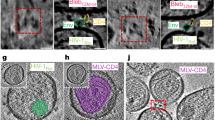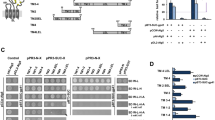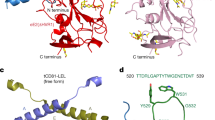Abstract
Binding of the human immunodeficiency virus (HIV) to infectable host cells, such as B and T lymphocytes, monocytes and colorectal cells, is mediated by a high-affinity interaction between the gp120 component of the viral envelope glycoprotein and the CD4 receptor1–5. Upon binding, it is thought that the second component of the envelope, gp41, mediates fusion between the viral envelope and host cell membranes6,7. However, the early steps of HIV infection have not yet been thoroughly elucidated. Viral entry was first reported to be mediated by pH-dependent receptor-mediated endocytosis8; subsequent studies have shown entry to be pH-independent9,10. Although direct fusion of virus to plasma membranes of infected cells has been observed by electron microscopy9, it is still formally possible that the infectious path of the virus involves receptor-mediated endocytosis. To gain a better understanding of receptor function in viral entry, we have analysed the ability of several altered or truncated forms of CD4 to serve as effective viral receptors. Our results indicate that domains beyond the HIV-binding region of CD4 are not required for viral infection. Some of the altered forms of CD4 that serve as effective HIV receptors are severely impaired in their ability to be endocytosed. These experiments therefore support the notion that viral fusion to the plasma membrane is sufficient for infection.
This is a preview of subscription content, access via your institution
Access options
Subscribe to this journal
Receive 51 print issues and online access
$199.00 per year
only $3.90 per issue
Buy this article
- Purchase on Springer Link
- Instant access to full article PDF
Prices may be subject to local taxes which are calculated during checkout
Similar content being viewed by others
References
Klatzmann, D. et al. Science 225, 59–63 (1984).
Dalgleish, A. G. et al. Nature 312, 763–766 (1984).
Adachi, A. et al. J. Virol. 61, 209–213 (1987).
McDougal, J. S. et al. Science 231, 382–385 (1986).
Lasky, L. A. et al. Cell 50, 975–985 (1987).
Gallaher, W. R. Cell 50, 327–328 (1987).
Kowalski, M. et al. Science 237, 1351–1355 (1987).
Maddon, P. J. et al. Cell 47, 333–348 (1986).
Stein, B. S. et al. Cell 49, 659–668 (1987).
McClure, M. O., Marsh, M. & Weiss, R. A. EMBO J. 7, 513–518 (1988).
Maddon, P. J. et al. Cell 42, 93–104 (1985).
Folks, T. et al. Science 231, 600–602 (1986).
Acres, R. B., Conlon, P. J., Mochizuki, D. Y. & Gallis, B. J. biol. Chem. 261, 16210–16214 (1986).
Blue, M., Hafler, D. A., Craig, K. A., Levine, H. & Schlossman, S. F. J. Immun. 139, 3949–3954 (1987).
Hoxie, J. A., Matthews, D. M., Callahan, K. J., Cassel, D. L. & Cooper, R. A. J. Immun. 137, 1194–1201 (1986).
Lin, C. R. et al. Cell 44, 839–848 (1986).
Rothenberger, S., Iacopetta, B. J. & Kuhn, L. C. Cell 49, 423–431 (1987).
Prywes, R., Livneh, E., Ullrich, A. & Schlessinger, J. EMBO J. 5, 2179–2190 (1986).
Lehrman, M. A., Goldstein, J. L., Brown, M. S., Russell, D. W. & Schneider, W. J. Cell 41, 735–743 (1985).
Doyle, C. & Strominger, J. Nature 330, 256–259 (1987).
Littman, D. R., Thomas, Y., Maddon, P. J., Chess, L. & Axel, R. Cell 40, 237–246 (1985).
Zoller, M. J. & Smith, M. Meth. Enzym. 100, 468–500 (1983).
Yamamoto, T. et al. Cell 39, 27–38 (1984).
Sanger, F., Nicklen, S. & Coulson, A. Proc. natn. Acad. Sci. U.S.A. 74, 5463–5467 (1977).
Mann, R., Mulligan, R. C. & Baltimore, D. Cell 33, 153–159 (1983).
Miller, A. D. & Buttimore, C. Molec. cell. Biol 6, 2895–2902 (1986).
Landau, N. R., Warton, M. & Littman, D. R. Nature 334, 159–162 (1988).
Barre-Sinoussi, F. et al. Science 110, 868–870 (1983).
Steimer, K. S. et al. Virology 150, 283–290 (1986).
Author information
Authors and Affiliations
Rights and permissions
About this article
Cite this article
Bedinger, P., Moriarty, A., von Borstel, R. et al. Internalization of the human immunodeficiency virus does not require the cytoplasmic domain of CD4. Nature 334, 162–165 (1988). https://doi.org/10.1038/334162a0
Received:
Accepted:
Issue Date:
DOI: https://doi.org/10.1038/334162a0
This article is cited by
-
Inhibition of HIV-1 endocytosis allows lipid mixing at the plasma membrane, but not complete fusion
Retrovirology (2011)
-
The Siva protein is a novel intracellular ligand of the CD4 receptor that promotes HIV-1 envelope-induced apoptosis in T-lymphoid cells
Apoptosis (2007)
-
Therapeutic potential of protein kinase C inhibitors
Agents and Actions (1993)
Comments
By submitting a comment you agree to abide by our Terms and Community Guidelines. If you find something abusive or that does not comply with our terms or guidelines please flag it as inappropriate.



